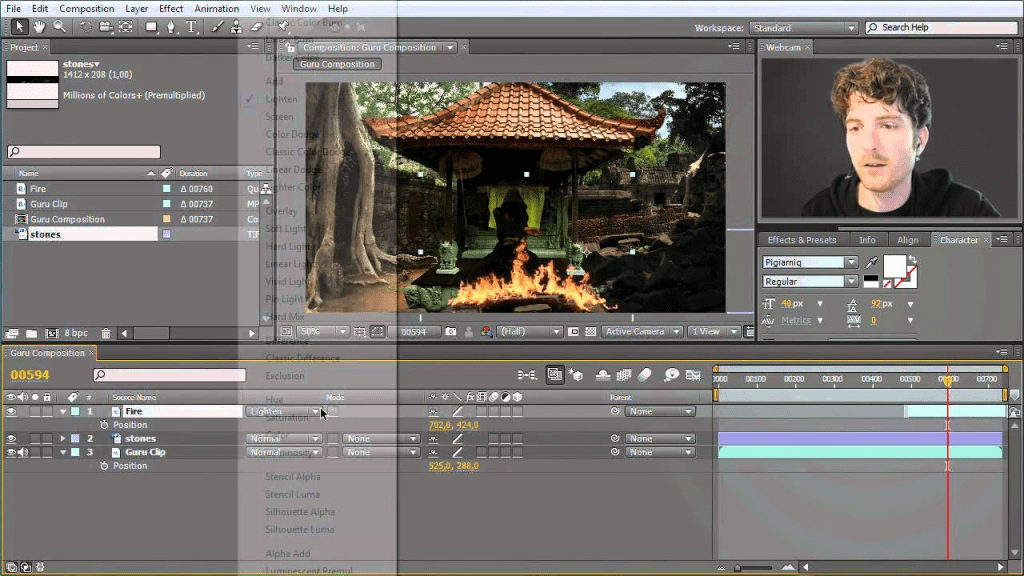After Effects Tutorials are essential for anyone looking to elevate their video editing skills, particularly when it comes to mastering video transitions. These tutorials guide you through the intricacies of creating stunning transition effects that can transform ordinary projects into visually captivating masterpieces. Whether you’re interested in techniques like wipe, dissolve, or zoom transitions, learning these effects will enable you to create professional video edits with ease. By incorporating the latest styles and methods, you’ll learn how to make your videos more engaging and fluid, mesmerizing your audience with seamless motion graphics. Dive into the world of After Effects and unlock your potential with these comprehensive tutorials, designed for both beginners and experienced editors alike.
In the realm of video production, mastering editing techniques and motion graphics is crucial for creating compelling content. Transition effects play a pivotal role in this process, allowing video editors to transition smoothly between scenes or elements within a project. Whether referred to as cinematic transitions or simply motion transitions, these skills are vital for anyone aiming to produce polished, professional-level videos. This article presents a variety of tutorials focused on crafting popular transition styles, thereby enhancing your projects with the artistry and flair they deserve. Get ready to explore the dynamic world of After Effects tutorials and elevate your video editing capabilities.
Wipe Transitions in After Effects
Wipe transitions in After Effects are a superb way to create a visually engaging switch between scenes. When done right, they can draw your viewers in and keep them engaged. This technique can range from simple linear wipes, which flawlessly slide one image out and bring another in, to more intricate options like radial and gradient wipes. Radial wipes can create captivating circular movements, while gradient wipes offer the creative possibility of blending colors for a more artistic transition.
To get started with wipe transitions, consider experimenting with the linear wipe option first. It serves as a great foundation for beginners to understand timing and movement, and as you build confidence, you can incorporate radial or gradient styles. For those eager to learn, our wipe transition tutorial will guide you in creating your own custom wipes with ease, utilizing downloadable project files for your convenience.
Dissolve Transitions in After Effects
Dissolve transitions possess a delicate charm that can enhance the emotional resonance of a video. By gradually fading one clip out while the next blends in, these transitions offer a subtle connection that maintains continuity and flow. They’re especially effective in narrative storytelling, where blending scenes fluidly keeps the viewer engaged without disruption.
In the accompanying dissolve transition tutorial, you’ll master the art of blending two clips seamlessly using opacity keyframes. The instructions are straightforward, even for those who are new to After Effects. By downloading our project files, integrating this technique into your videos will be a breeze, ensuring that each shift feels as natural as breathing.
Mask Transitions in After Effects
Mask transitions represent a powerful tool for video creators who want to direct the viewer’s attention. By utilizing shapes or custom masks, you can cleverly reveal or close off various components within your scene. This technique captivates viewers, providing a visually dynamic experience that encourages them to discover hidden layers of your narrative.
Our ‘Walk By Transition’ tutorial exemplifies how easily one can command this technique. With step-by-step guidance, you’ll learn the essential ‘masking’ skills that will take your video editing up a notch. Whether you’re aiming for simplicity or complexity, mastering these transitions can elevate the professional quality of your projects.
Zoom Transitions in After Effects
Zoom transitions imbue your videos with a dramatic flair that captivates audiences. The idea of zooming in or out allows for a striking showcase of details in specific areas, making the transitions feel dynamic and engaging. This can emphasize critical moments or themes within your video, enhancing viewers’ emotional connections to the content.
Our short tutorial on zoom transitions is designed for speed and efficiency—learn how to create an impactful zoom transition in under two minutes! By quickly understanding the underlying concept and applying it to your projects, you’ll soon be incorporating zoom transitions into your editing toolbox with confidence.
Blur Transitions in After Effects
With a professional video aesthetic, blur transitions provide an ethereal quality that can be mesmerizing. This technique, which incorporates a blur effect during the shift between scenes, can lend a cinematic feel to your projects. It often signals a change in mood or thematic focus, which can deepen viewer engagement.
Our blur transition tutorial walks you through the process of achieving stunning results with this effect. Follow the engaging steps outlined in the instructions, and you’ll soon discover how to blend scenes beautifully while maintaining an artistic flair and professional look.
Glitch Transitions in After Effects
For those looking to convey a modern, edgy style in their videos, glitch transitions are a perfect fit. This effect injects a vibrant energy into your scenes, creating an aesthetic that resonates well in contemporary storytelling. The technologically inspired nature of your video can significantly shift when you incorporate glitch elements to capture the attention of viewers.
Our custom glitch transition tutorial illustrates how to effectively create this effect without relying on any external plugins. With clear instructions, you’ll have the tools necessary to craft unique transitions that will give your videos a bold standout quality, enhancing their visual storytelling.
Fade Transitions in After Effects
Fade transitions are timeless. They offer a gentle yet effective way to switch between scenes, creating a natural flow in your video’s progression. Fade in and fade out effects can be particularly soothing for viewers and are often used to signify the end of a segment or the transition into a new chapter.
In our fade transition tutorial, you will learn the straightforward steps to implement these effects at both the beginning and end of clips. Whether you’re looking for simplicity or an elegant transition, mastering this technique allows a seamless experience for your viewers, heightening their connection to the narrative.
Textured Transitions in After Effects
Textured transitions give your videos a unique layer of artistic flair. This method enables you to mix visual materials or graphic elements, creating a transition that feels custom and crafted specifically for your content. It can add depth and intrigue to your storytelling.
The textured transition tutorial will demonstrate how to embrace creativity by employing various textures between scenes. This hands-on guide inspires you to break from traditional transitions, encouraging experimentation that can lead to stunning visual outcomes in your projects.
Push Transitions in After Effects
Push transitions are all about action and energy. This dynamic approach allows one scene to push the previous one out of view, propelling your narrative forward. It’s a fantastic way to maintain momentum and engagement as viewers move seamlessly through your video.
Our push transition tutorial will arm you with the skills to create an impressive push wipe transition effectively. The detailed steps ensure that even beginners can achieve professional-looking results that invigorate their projects, bringing them to life in a purposeful and energetic manner.
Ripple Transitions in After Effects
Ripple transitions introduce a magical quality that can mesmerize viewers. This effect, which simulates a ripple flowing across the screen, can evoke feelings of surprise and delight, adding a unique twist to your video transitions. It’s particularly effective for whimsical or imaginative themes.
In our ripple transition tutorial, you’ll learn how to create stunning initial ripple effects and maintain that impact throughout your transitions. By following the instructions step-by-step, you will be able to enchant your audience with visually striking and memorable transitions that elevate your storytelling.
Tear Transitions in After Effects
Tear transitions are excellent for adding drama and engagement to your videos. They simulate a tearing effect, as if the screen itself is ripping apart to reveal the next scene. This powerful visual technique can hold significant emotional impact, making it a perfect choice for intense storytelling.
Our tear transition tutorial provides a detailed approach to integrating this fascinating effect into your projects. With step-by-step guidance, you’ll swiftly learn how to create torn paper transitions that will captivate your audience and leave a lasting impression.
Tips for Choosing & Using Transition Effects
When it comes to selecting transition effects, it’s vital to consider the overall tone and mood of your video. Each transition carries its nuances; hence, they should compliment your video’s style rather than distract from it. While it might be tempting to showcase various effects, maintaining a cohesive flow often yields the most impactful results.
Moreover, be mindful of the speed and duration of transitions. Proper timing can amplify the emotion and resonance of your visuals. Transition effects should harmonize with the pacing of your scenes, enhancing the storytelling without overpowering it. This balance is key to crafting a professional and polished final product.
Transitions in After Effects FAQs
Transition effects serve as dynamic animations that bind different scenes or clips together. They facilitate smooth transitions, which can enhance the viewing experience when applied correctly. Understanding their functionality can significantly boost the creative possibilities in your edits.
Addressing common concerns, many transitioning effects in After Effects can be achieved without additional plugins, relying solely on the built-in tools. However, for specific effects, plugins may provide enhanced capabilities. If you face challenges with rendering, reviewing your render settings is essential to ensure a smooth workflow in your projects.
Learning Transitions in After Effects
To truly excel at video editing, mastering transition effects in After Effects is crucial. These skills directly influence the quality and impact of your videos, allowing you to engage viewers effectively. Whether you’re telling a story or presenting information, quality transitions can elevate your production.
Regular practice and exploration of different effects and their applications will lead to great expertise in this area. Don’t hesitate to experiment and find your unique style within the myriad of possibilities that After Effects provides, ensuring that your videos stand out in a crowded digital landscape.
More After Effects Templates
Explore our extensive library of After Effects templates, designed to streamline your workflow and elevate your video projects. From intros and slideshows to logo reveals and lower thirds, these resources offer an efficient way to integrate professional designs into your work.
Whether you’re a beginner seeking simplicity or an experienced editor in search of unique visuals, our diverse collection has something to meet your needs. Ensure your projects shine and captivate audiences by utilizing high-quality preset options tailored to various themes and goals.

Conclusion
In conclusion, mastering transition effects in After Effects is essential for any video creator looking to enhance their projects and captivate their audience. The variety of transition styles—from wipes and dissolves to more creative options like glitch and ripple transitions—provides countless ways to tailor content to match a specific tone or theme. By employing these techniques, you ensure that your videos not only maintain viewer engagement but also reflect a polished and professional aesthetic. Here are some key takeaways about using transitions in After Effects:
– Choose transitions that align with your video’s overall style and mood.
– Limit the number of different transitions in a single video to avoid overwhelming the audience.
– Pay attention to the duration of transitions to match the pacing of your video.
Ultimately, the ability to create seamless and visually appealing transitions can elevate your work significantly. As you explore the After Effects tutorials mentioned, you’ll build a strong foundation in using these effects creatively, making your videos stand out in a crowded digital landscape. Transition effects can serve as powerful storytelling tools, guiding viewers through the narrative with engaging visual cues. Remember to continually experiment and refine your approach to find the styles that resonate best with your unique artistic vision. As you embark on or continue your journey in motion design, keep these insights in mind to enhance your storytelling capabilities.















